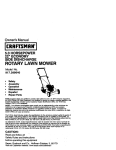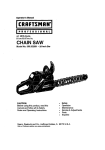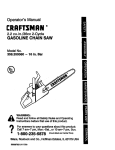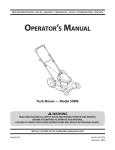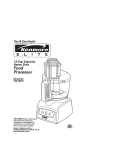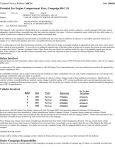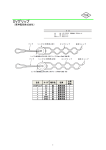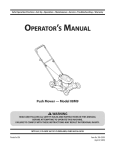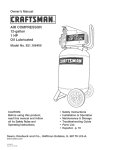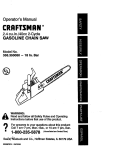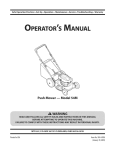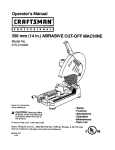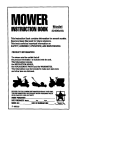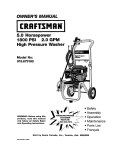Download Craftsman 360.352001 Operator`s manual
Transcript
Operator's Manual iPROFESSIONAL I 4.1 HP/2-Cycle 51 ccJ3.15 cu. in. CHAIN SAW Model No. 360.352001 - 20-inch Bar NOTICE: There Is a typographlcal _rror in this manual. The correct model number is: 360.352010 CAUTION: Before using this product, read this manual and follow all its Safety Rules and Operating Instructions. Sears, Roebuck and Co., Hoffman • • • • • • Estates, Visit our Craftsman website: www.sears.conYcraftsman Safety Operation Maintenance Service & Adjustments Parts LIBRARY: EspaSol IL 60179 U.S.A. • • • • • • • • Warranty Safety Assembly Contents of Carton Accessories Operation How to Use Your Chain Saw Safe Felling and Cutting Techniques Pg. Pg. Pg. Pg. Pg Pg. Pg. 2 3 4 4 5 5 5 • _ Maintenance • Service & Adjustments • Storage * Troubleshooting • California Emission Control Warranty Statement • Parts • Espafiol Pg.10 Pg.12 Pg.14 Pg.15 Pg.15 Pg.17 Pg.21 Pg. 7 UMITED TWO YEAR WARRANTY For two (2) years from the date of pumhase if the chain saw is maintained, lubricated and tuned up according to the instructions in the Operator's Manual, Sears will repair or replace, free of charge, any parts found to be defective in material or workmanship. If this product ls used commemially, this viarranty only applies for 90 days. This warranty does not cover:. • Expendable items which become worn during normal use, such as spark plugs and air filters. • Repairs necessary because of operator abuse, negligence, improper storage, accident or the failure to maintain the equipment according to the instructionscontained in the operator's manual Warranty service is available by returning the chain saw to the nearest Sears Service Center in the United States. This warranty gives you specific legal fights, and you may also have other rights which may vary from state to state. Sears, Roebuck and Co., Dept. 817WA, Hoffman Estates, IL 60179 PRODUCT SPECIFICATIONS Horse Power _. 4.1 U.S.o1"20 oz. :ue-Otl Capacity, :ueI-Oil Mix 40-I Bosch WSR6Y _parkRug '_Gap .020 In) Champion RCJ-bY DIITank Capacity 20 oz. 51 cc Engine Displacement Maximum RPM 12,500rpm Dry Weight 10.75lbs. YlodelNo. 360.352001 Serial No. Dateof Purchase The model and serial number will be found on the rear handle. You should record both serial number and date of purchase and keep in a safe place for future reference. 2 (,,,"9'_! _1_ nk,"d llL_,=,_ijt]lllO]llU_o_ CAUTION: Always disconnect spark plug wire and place where it cannot contact sparl_plug to prevent accidental starting when setting up, transporting, adjusting or making repairs. TRAINING Read the operator's manual carefully prior to operation. Become familiar with the controls and know how to operate your chain saw properly. OPERATION • • • • • • • Keep the area of operation clear of all persons, especially small children and pets. Use the chain saw only as described in this • manual. • Do not allow children to operate your chain saw. Never allow adults to use the chain saw without proper instructions. Do not operate the chain saw if it has been dropped or damaged in any manner. Always have damage repaired before using your chain saw. Use only recommended Craftsman accessories and replacement parts. Use of non-Craftsman parts and accessories may be hazardous. • • • PREPARATION • Always wear safety glasse s or eye shields when starting and while using your Chain saw. • Dress properly. Do not operate chain saw when barefoot or wearing open sandals. Wear only solid shoes with good traction. • Wear long-sleeved clothes that are snug fitting. Avoid wearing loose clothing. • Wear either tightly cuffed or cuffless pants. • Wear hearing protection even when working for a short period of time. Remember - hearing damage is cumulative. • Wear protective, non-slip gloves for safer operation. • Always wear a =hard hat" in the working area. Overhead hazards such as falling limbs present danger of injury. • Always wear safety boots with steel toes. • Check fuel tank before starting engine. Do not fill fuel tank indoors, when the engine is running or when the engine is hot. Allow the engine to cool for several minutes before filling the fuel tank. Clean off any spilled gasoline before starting the engine. • Always make adjustments before starting your chain saw. Never attempt to make adjustments while the engine is running. • Use only in daylight or good artificial light. • • Keep your eyes and mind on your chain saw. Do not let yourself be distracted. Always be sure of your footing. Use extra caution in wet or slippery grass. WALK - DON_f RUN. Do not put hands or feet near rotating parts. Keep clear of chain at all times. Always stop the engine whenever you leave or are not using your chain saw. Before cleaning, inspecting, or repairing your chain saw, stop the engine and make absolutely sure all moving parts have stopped. Then disconnect spark plug wire and keep it away from the sPark plug to prevent accidental starting. D° not adjust carburetor. Overspeeding engine may result in engine damage or personal injury. Do not runthe engine indoors. Exhaust fumes are dangerous. Never operate your chain saw without proper guards or other safety devices in place. Never remove hands from chain saw handles when actively cutting with the saw. WARNING: Ca/ifemia Proposition 65 The engine exhaust from this product contains chemicals known to the State of California to cause cancer, birth defects, or other reproductive harm. KICKBACK CONDITIONS AND PREVENTION Kickback occurs when the upper quadrant of the bar nose contacts a solid object in the wood or is pinched. This type of contact stops the chain for an instant. The result is a lightningfast reverse reaction of the chain; causing the bar to "kick" up and back toward the operator. Under some circumstances the operator (Fig. 1) may suffer severe or fatal injury. Kickback may also occur during limbing (See LIMBING). FIGURE 1 Kickback path 3 TO AVOID KICKBACK The best protection from personal injury that may result from Kickback is to avoid Kickback situations. s_cond. The chain brake can also be engaged manually by pushing the lever-handguard towards the front of the saw until a loud click is heard. The saw should not be run above idle for more than a few seconds with the brake engaged; otherwise damage to the saw will occur. • Hold the chain saw firmly with both hands and maintain a secure grip. • Be aware of the location of the guide bar nose at all times (Fig. 2). FIGURE 2 To propedy disengage the chain brake; firmly pull the lever-hand guard back towards the handle (Fig. 3) until a loud click is heard. Failure to completely disengage the brake propedy will cause excessive heat build-up on the brake band which, in turn, can cause severe damage to the saw body. r RGURE 3 • ,_,. _ • Lever.handguard Do not let the bar contactthe ground • • • • • • • • • • • Never bring the nose of the guide bar in contact with any object. Do not cut limbs with the nose of the guide bar. Be especially careful with small, tough limbs, small-size brush, and saplings which may easily catch the chain. Don't overreach. CUSTOMER • • • Don't cut above shoulder height. Do not use a chain saw while standing on a tree or laddeH Begin and continue cutting at full throttle. Cut only one lot at a time. Use extreme caution when re-entering a previous cut. RESPONSIBILITIES Read and observe the safety rules. Follow a regular schedule in maintaining, caring and using your chain saw. Follow the instructions under the Maintenance and Storage sections of this manual. SPECIAL NOTICE: For usel:s on U.S. Forest Land and in some states, including California (Public Resources Code 4442 and 4443), Idaho, Maine, Minnesota, New Jersey, Oregon and Washington: Certain internal combustion engines operated on forest, brush, and/or grass-covered land in the above areas are required to be equipped with a spark arrestor, maintained for the prevention of fire. Check with your state or local authorities for regulations • pertaining to these requirements. Failure to follow these requirements is a violation of the law. This unit is not factory-equipped with a spark arrestor;, however, a spark arrestor is available as an optional part. If a spark arrestor is required in your area, contact your Authorized Service Center for the correct kit. Do not attempt plunge cuts if you are not familiar with these cutting techniques. Be alert of shifting log or other forces that may cause the cut to close and pinch the chain. Maintain saw chain properly. Cut with a correctly sharpened, properly tensioned chain at all times (Use a 4.5-mm file). Stand to the side of cutting path of the chain saw. If the cut closes on the bar, STOP the saw. Use a wedge to free the saw. Do not try to free it by pulling the handle. WARNING: A dull or improperly sharpened chain may increase the dsk of Kickback. Always cut with a properly sharpened saw. Improper lowering of the depth gauges also increases the chance of kickback. Your new chain saw has been assembled at the factory. No further assembly is necessary. ABOUT THE CHAIN BRAKE The main components of the chain brake assembly are the lever-handguard and a brake band around the clutch drum. The brake is automatically engaged when kickback occurs. When engaged, the brake band clamps down around the clutch drum, stopping both the drum and the chain in less than 1/10 of one • • Chain Saw Combi-Wrench Read these instructions and the operating manual in its entirety before you attempt to operate your new chain saw. 4 The , • • • following items for the operation of your chain saw are available at your nearest Sears store.Safety goggles • Air filter Hearing protection • Fuel Stabilizer Gloves * Spark plug 2-Cycle air cooled engine oil • Gas can KNOW YOUR CHAIN SAW Read this Operator's Manual and Safety Instructions before operating your chain saw. Compare the illustration below (Figure 4) with your chain saw to familiarize yourself with the location of various controls and adjustments. Save this manual for future reference. 1. Spark Plug 2. Air Filter 3. Primer 4. Choke Lever 5. On-Off Switch 6. Safety Lever 7. Throttle Lever 8. Fuel-Oil Mix Cap 9, Cover Over Pre-Filter 10. Bar-Chain Oil Cap 11. Bar 12. Chain 13. Bar Nuts 14. 15. 16. 17. 18. 19. 20. 21. 22. 23. 24. 25. Half Throttle Pin (Pg. 6) Side Cover Top Cover Lever- Handguard (Pg. 4) Bucking Spike Chain Tensioning Screw Chain Tensioning Lug Clutch Drum Chain Brake Band Oil Adjustment Screw Sprocket Serial Number FIGURE 4 _,[o]l,_?j do] [1_I= i'Lo]ll;7 [_ GASOLINE _?:lvlvA bearings and other moving pads. The correct fuel- oil mixture is 40:1 (see Fuel Mixture Chart). Too little oil or the incorrect oil type will cause poor performance and may cause the engine to overheat and seize. AND OIL MIXTURE Importantl Do not use automotive or boat oils in your chain saw. These oils do not have proper additives for 2-cycle, air-cooled engines and can cause engine damage. Gasoline and oil must be premixed in a clean approved fuel container. Always use fresh regular unleaded gasoline. This engine is codified to operate on unleaded gasoline. The 2-cycle engine on this product requires a fuel mixture of regular unleaded gasoline and a high quality 2-cycle air-cooled engine oil for lubrication of the 5 FUEL MIXTURE CHART GASOUNE I Gallon 2.5 Ganons counterclockwise (+) increases the amount of oil, clockwise (-) decreases the flow. Never cut without chain lubrication. Check proper level before each cutting. OIL 3.2 Ounces 8.0 Ounces RGURE 5 MPORTANT! ,Alcohol blended fuels called gasohol using ethanol or methanol) can attract moisture, _hich leads to fuel - oil separation'and formation of Lcids during storage. Acidic gas can damage the fuel system of an engine while in storage. To avoid engine problems, the fuel system should be emptied before storage of 30 days or longer. Drain the gas tank, then run the fuel out of the carburetor and fuel lines by starling the engine and letting it run until it stops. Use fresh fuel next season. See storage instructions for eddltior_l information. Never use engine or carburetor cleaner products in the fuel tank or permanent damage may occur. STOPPING STARTING COLD NOTE: Check chain tension before startingl 1. Tum the on-off switch to the on "1"position. 2. Pull out the choke knob. The fast idle stays set until the throttle is depressed, at which time the red pin inside the choke lever retracts (idle position). CAUTION: Retain a secure gdp on the saw using the foot and hand position for starting the chain saw in a safe manner. 3. Pump fuel primer until it is approximately ½ full with fuel and increased resistance is felt. Proceed with cold starting instructions. 4. Slowly pull on starter grip until rope encounters some resistance from starter pulley. Next, pu_l rope firmly and rapidly in an upward motion. Guide rope back into starter rather than letting it snap back. 5. Repeat rope pulls until engine attempts to start, usually 2-3 pulls, no more than 5; then immediately push in choke knob. 6. Once the engine is steadily running depress and release the throttle lever to allow engine to operate at idle speed. NOTE: Depressing (and then releasing) the throttle lever releases the halfthrottle automatic lock and the red indicator pin on the choke knob retracts. The engine continues to run at idle speed. 7. Should the engine fail to start after several repeated starting attempts, the engine has already been "flooded" (too much fuel mixture in cylinder). In this case, remove the spark plug and dry it. Set the ignition switch to "stop"and the throttle lever to full throttle. Crank engine by pulling the starter rope several times to vent fuel mix and vapors from cylinder and crankcase. Check spark plug gap (.015-.020"); correct if necessary. Reinstall spark plug; connect spark plug cap. Set ignition 2-CYCLE OIL Craftsman 2-cycle, air-cooled engine oil is specially blended with fuel stabilizers. If you do not use this Sears oil, you can add a fuel stabilizer, such as Craftsman No. 33500, to your fuel mix. FUEL STABILIZER A fuel stabilizer is an acceptable altemative in minimizing the formation of fuel gum deposits during storage. Add stabilizer to gasoline mixture in fuel storage container and mix well. Always follow the fuel mix ratio found on the stabilizer container. Run engine at least 5 minutes after adding stabilizer to allow the stabilizer to reach the carburetor, You do not have to drain the fuel tank for storage if you are using fuel stabilizer. BAR AND CHAIN ENGINE To stop engine, release the throttle lever. Move the On-Off switch to the oft (STOP) position. OIL We recommend a special chain oil (low sling, high tack) to lubricate your bar and chain; consult your local Sears retailer. During chain saw operations at temperatures below freezing (0°C/32°F), the chain oil viscosity increases creating an ovedoad to the automatic oil pump. Overloading results in damage to the driver gear, pump mechanism, and bar and chain. A special cold-climate chain oil should be used. Refill chain oil each time you refuel. CAUTION: Never use waste engine oil; it will damage the pump. OIL PUMP Your chain saw is equipped with an automatic oil pump that pumps oil to the chain when the chain is rotating. You may adjust the amount of oil pumped to compensate for long bars and chains or for extremely hard or frozen wood. Adjust the flow rate by turning the adjustment screw. The adjustment screw is located on the bottom of the saw below the markings + - on the same side as the bar and chain (Fig. 5). Turning b RGURE 6 STARTING WARM I. Pull choke knob out. 2. Push choke knob back into open position, red indicator pin on choke button remains visible. 3. Crank engine and allow to run briefly. 4. Depress throttle lever to allow engine to run at idle speed (indicator pin disappears). If you are unsuccessful in starting the engine, consult the Troubleshooting guide in your Craftsman chain saw handbook or contact a Sears Sen/ice Center. Clear escape route by removing undergiowth likely to interfere with escape. Be sure to warn others by .... shouting =TIMBER" when a tree is about to fall. Brief each team member on proper escape procedures and signals. Have visual contact with team members prior to and during felling operation. Practice a "dry run" escape! Prior to felling prepare the immediate site and the base of the tree by clearing away undergrowth with an axe, not the saw. Undergrowth can tangle up or snag the saw Fhain resulting in serious injury or saw damage. Clean the trunk of brush and remove small branches from the lower trunk with a small axe. Before felling a tree, survey it carefully and answer these questions: 1. 2. 3. 4. 5. In which direction does the tree lean? Is the condition of the trunk sound, hollow or partially rotten? From which direction is the wind blowing? What is the wind velocity? CAUTION: Wind direction and velocity may change. Be alert! Felling should not be attempted in high winds. Is the crown (top) of the tree more dense and heavier on one side? Remove large buttress roots first. Start by cutting the largest buttress root. Remove each by cutting it vertically first, then horizontally (Fig. 7). Small buttress roots can be removed when felling is complete unless they hamper the felling process. These are factors and forces which will influence the line of fall and escape routes, Survey the area; make sure that felled trees cannot strike any objects such as power lines, buildings, cars and block roadways or railroad tracks. Insure that neither persons nor animals are within the danger zone (measured distance away from tree that is 21/= times the tree height). RGURE 7 NOTE: These basic rules apply to felling a single tree or many. However, and additional organizing is required when felling several trees. Preliminary preparation must be done outside the danger zone. Be sure others know where you are and what you are doing at all times. CAUTION: DO not try to fell a tree along a line different from its natural line of fall unless you have considerable experience. When felling, assume a balanced body position (Fig. 8). Position the feet parallel and apart to obtain a steady stance and stand at the side of the tree. Lower the point of gravity by bending the knees (comfortably arch your back). Keep the saw near the body, hold it firmly with both hands, and lock the thumbs under the handlebar at all times. Determine carefully the correct line of fall. Clear two safe exit paths to the rear (clear away escape routes for each member of the felling team). Do not place tools and equipment in the path. Make your escape route at a 45 ° angle back and away from the line of fall " (Fig. 6). 7 FIGURE 8 CAUTION: Maintain good footing, body balance and insure a safe escape path has been established. Never fell a tree without making a proper felling notch (undercut). The next cut (Fig. 11) is called the felling cut (back cut). Make it at least 2" higher than the lower cut of the felling notch by cutting horizontally and parallel to the felling notch. Do not cut through to the felling notch. Leave a "hinge" of uncut wood approximately 1/10 of the tree diameter (Fig. 11). CUTTING FELLING WARNING: To avoid personal injury, do not cut through the hinge! A proper hinge prevents the tree from possibly =sitting back" or "butt kicking" the back of the stump, twisting off the stump, or falling prematurely and uncontrolled. NOTCH Start felling by making a careful felling notch (undercut) first (Fig. 9). This notch determines the line of fall. Position it at a dght angle. Cut the felling notch to a depth of about t/, of the trunk diameter. It must be wide enough and should never be higher than its depth. When felling a large tree, drive wedges into the felling cut. Use only wooden or plastic wedges. Never use steel or iron wedges which can cause kickback and damage to the chain. Wedges prevent the tree from settling back on the bar and help control the direction of the fall toward the felling notch (fig. 12)o FIGURE 9 Felling FIGURE 12 To make the felling notch, start with the upper cut facing the line of fall. This is a directional cut downwards at an angle (Fig. 10, 1). Next, make the lower felling notch cut. Cut hodzontally and straight into the tree until it meets the upper cut forming a wedge (Fig. 10, 2). RGURE SMALL TREES If the trunk diameter is smaller than the guide bar cutting length, be careful making the felling cut and forming the hinge. Once the felling cut has been made, ,place the bucking spike at the base line dght behind the hinge, and do a fan cut (Fig. 13). 10 FIGURE 13 Direction of fan cut The ex_ when the tree is on a slope; then the lower cut should be on an upward angle to cut a larger, more open wedge and to gain greater control dudng the fall of the tree (Fig. 11). Hinge_ The bucking spike is the toothed metal piece attached to the front of the saw body and found to the left of the bar. With the bucking spike teeth against the log firm contact between the saw body and the log are maintained. A fan cut is accomplished by first contacting the teeth of the bucking spike to the log and then, using the bucking spike as the pivot point, rotating the bar through the log in a counterclockwise direction. FIGURE 11 8 6. Craftsman saws are designed to allow the powerhead to glide over the trunk during limbing. Cut the branches in a swinging back and forth movement with the saw remaining on the tree. This is known as the =pendulum method." 7. Prior to cutting the branches, consider the direction in which the branches may fall. This will determine whether you cut from the top down (overbuck, Fig. 16) or from below up (underbuck, Fig. 17). 8. Watch out for branches under tension which can snap back. Tension must be removed before these branches can be safely cut. Beware of potential kickback situations. 9. If large branches are to be used for firewood, cut them to length while still attached to the tree. This is an easier and safer method than bucking branches on the ground (Fig. 16 & 17). 10. If you tire during limbing, STOP! Rest, then resume work. 11. Never change the position of the feet or hands while in the midst of a cut. ._ LIMBING (Removing limbs from felled trees) WARNING: Of all the cutting operations, limbing is the one that holds the most chance of unforeseen injury. The danger of kickback is most prevalent during limbing if the bar nose comes in contact with another branch or the side of the tree (see "Kickback Conditions and Prevention"). Professional loggers have developed various safe, efficient and effective limbing techniques which you must follow. The following instructions are a few of the basic safe work habits for a chain saw operator while limbing or removing branches from a tree. .1. Before starting to limb, be sure the branch is on a safe side of the log, uphill, and on the side opposite of any potential motion the cut branch might make (Fig. 14). FIGURE 14 FIGURE 16 Overbucklng 2. 3. 4. Do not stand on a log while limbing. You may slip, fall or the log may roll. Maintain sure footing. Never use the bar nose to cut branches. Bend the knees slightly. Position the right leg behind the left side of the chain saw and the left leg forward and outward away from contact range of bar. Assume a comfortable stance with the feet spread apart. CAUTION: If you change position, the bar must always be on the side of the tree opposite you. Keep the tree trunk between you and the bar. 5. FIGURE 17 Underbucking Rest the chain saw body on the trunk as much as possible(Fig. 15). FIGURE 15 9 FIGURE 20 BUCKING (The cutting of a log into sections): 1. Be alert to the stress and motion of logs. Always position yourself to prevent the rolling of a cut log section or the stress forces within a log from acting against you. 2. Never stand directly behind the chain saw when cutting. Stand to the left side of the cutting path of the chain saw to reduce the chances of injury from kickback or a broken chain shooting backwards towards you (Fig. 18, 1). 3. Bend the knees slightly. Assume a comfortable stance with the feet spread apart (Fig. 18, 2). 4. Keep the left elbow straight while cutting (Fig. 18, 3). 5. Lock the thumb under the handlebar (Fig. 18, 4). WARNING: Logs and branches may be under stress or tension. Before cutting check to see if stress exists. If stress does exists, start to cut on the right side of the log or branch to prevent pinching and possible kickback situations so that the branch does not whip back and strike you. 9. If the chain bar is pinched while bucking, shut off the engine immediately. FIGURE 18 IMPORTANT! If the bar and chain become pinched, do not try to wrench or twist the bar free. Move the log into another position or lift up with a rod or lever (Fig. 21). FIGURE 21 6. 7. Set the bucking spikes firmly against the log. When cutting firewood, place the log on a suitable support such as a saw buck (Fig. 19). RGURE 19 GENERAL RECOMMENDATIONS The warranty on this chain saw does not cover items that have been subjected to operator abuse or negligence. To receive full value from the warranty, operator must maintain chain saw as instructed in this manual. All items in the Maintenance section of this manual should be checked at least once each season. 1. 8. 2. Free hanging ends can be cut off without risk of bar pinching. But if the wood is not to split or tear, make an undercut (underbucking, Fig. 20, 1) of about 1/3 the depth of the log diameter, then apply the finishing cut (overbucking, Fig. 20, 2). ]0 Service more often when operating in dusty or dirty conditions. Once a year you should replace the spark plug and clean or replace the air filter. A new spark plug and a clean air filter assure proper air-fuel mixture and help your engine run better and last longer. MAINTENANCE CHECK CHAIN SHARPNESS A sharp chain makes wood chips. A dull chain makes a sawdust powder and cuts slowly. Chain sharpening requires special tools. You can purchase sharpening tools at Sears or go to a professional chain sharpener. SCHEDULE FIGURE 22 REFILL BAR AND CHAIN OIL Your saw will use approximately one tank of bar oil for every tank of fuel mix. Always fill bar oil tank when you fill the fuel tank. For maximum bar and chain life, we recommend you use Craftsman chain saw bar oil. If Craftsman bar oil is not available, you may use a high quality bar and chain oil. CAUTION: Only use bar and chain oil; do not use motor oil. Motor oil will damage the saw. m Check for loose fasteners & parts Checkfor,_damaged or worn parts Check chai_tension Check chainsharpness x x x X :_efill.barand chainoil Inspectbar .?.lean enginecoolingfins _leanair filter& pre-filter INSPECT BAR Keep bar rails square and flat. Check for inside groove wear as follows. Place a straight edge (Fig. 23, A) against side of bar and one cutter. If there is clearance (Fig. 23, B) between bar and straight edge, the bar rails are good. If the chain leans (Fig._24) and there is no clearance between bar and straight'edge (Fig. 24, B), the bar rails are wom. Straightening worn bars, under certain circumstances, can only be done by service technicians. Replace bar if un-repairable. IMPORTANT: To prevent One-sided wear of the bar, flip the bar over after each chain sharpening. X X X X Replace sparkplug X Cleanfuel filter X Inspect muffler X Cleanspark arrestor X RGURE 23 ii .-.%,.._ CHECK FOR LOOSE FASTENERS & PARTS Check all fasteners, including nuts, bolts, screws and clamps, to insure that they are tight and secure, If not, make all necessary adjustments prior to using chain M Good saw. RGURE 24 CHECK FOR DAMAGED OR WORN PARTS r---1 Replacement of damaged or worn parts should be referred to your Sears Service Center • On-Off Switch - Check function of the switch by running the saw then turning the switch to the "off" position. The engine should stop; then turn to the "on" position and restart. • Fuel Tank & Oil Tank - Do not use the saw if oil or fuel leaks from the unit. NOTE: It is normal for a small amount of oil to drip from the bar and the side where the chain adjustment pin is located. _.j. ,._ M Wom WARNING: Be Sure chain is properly tensioned. A sagging chain (Fig. 25) can jump out of the bar groove and even break. CHECK CHAIN TENSION If the chain is too loose it can come off the bar and possibly cause injury. DO NOT operate the saw if the chain is loose. To set your chain to the proper tension refer to Chain Tension in the Service and Adjustmentsection. FIGURE 25 Sagging chain 1] Clean the oil inlet hole (Fig. 26, A) and the bar groove prior to placing the chain in the bar groove. RGURE 28 Retainingclip FIGURE 26 Pre-fllter Air filter REPLACE SPARK PLUG Change your spark plug each year to make your engine start easy and run better. Set spark plug gap at .020". With sprocket nose bars (Fig. 27), grease the bearings of the sprocket with a grease gun containing bearing grease. Pump the grease into the clean.ed out holes while rotating the sprocket. WARNING: Wear gloves when handling chain to prevent injury. CLEAN FUEL FILTER The fuel filter is located inside the fuel tank and is attached to the fuel line. To clean, scrub with a small RGURE 27 INSPECT MUFFLER brush. Replace if deteriorated, Inspect muffler every 25 hours of use and replace if corroded. CLEAN SPARK ARRESTOR SCREEN (if installed) After every 25 hours of use the spark arrestor screen must be cleaned. Replace screen if deteriorating (part no. 2048391). To clean: 1. Remove screen. 2. Clean using a wire brush. 3. Reinstall. IMPORTANTI The bar is designed specifically to be a track for the chain. Never use bar to pry, lift or twist. CLEAN ENGINE COOLING RNS [.,._=l;_rJ[_Idr-1_1,1-I m]lJl_-]l|_[:l_ For best performance, keep dirt from accumulating around the engine cooling fins. Clogged cooling fins cause the engine to run hotter and shorten engine life. Cooling fins may be cleaned using a toothbrush or stiff bdstle brush. CHAIN CLEAN AIR FILTER & PRE-FILTER Your engine will not run properly and may be damaged by using a dirty air filter and/or pre-filter. Replace if deterioration occurs. Service more often if you use your chain saw in very dusty or dirtyconditions. WARNING: Be sure the chain is properly tensioned. A sagging chain can jump out of the bar groove, break, and cause sedous injury, To Clean Air Filter & Pre-Filter: 1. Remove air filter Cover. 2. Remove pre-fllter and air filter (Fig. 28). To remove air filter, slide retaining clip off and pull up on air filter. 3. 4. 5. TENSION Correct chain tension is very important to insure a long service life for the chain. Check the chain tension each time the saw is stopped and the bar and chain have cooled off. Check the tension and the chain and bar lubdcation frequently during prolonged pedods of cutting. If the chain is loose, lubricate it well and let it cool off before readjusting the tension. The chain tension needs adjusting if the chain is sagging away from the underside of the bar when the saw is held updght (Fig. 29). Clean air filter with soft brush or tap lightly, If heavily soiled, rinse in a mild soap and water solution. The pre-filter must be blown clean with compressed air, Dry air filter completely. Reassemble the pre-filter and air filter; ensui'e that they are correctly seated before reinstalling. Replace filters if deteriorating, RGURE29 Saggingchain 12 RGURE 33 WARNING: Shut off engine before attempting to adjust the chain tension. Additionally, disconnect the spark plug wire. Wear gloves when handling chains to prevent injury. To adjust the tension: 1. Loosen the bar nuts using the Combi-wrench. 2. Turn the tension screw clockwise (Fig. 30, 1) until 'the chain touches and no longer sags at the underside of the bar. FIGURE 30 2. Clean the surface between the bar and the guide plate (Fig. 34, A); and the oilier opening (Fig 34, 3. Turn the chain tensioning screw (Fig. 34, C) counterclockwise to position the tension lug (Fig. 34, D) to the far left. Slide the bar over the tension tug and fit securely into lughole. Failure to fit the lug into the hole may result in the tension screw being bent when the side cover is tightened down. B). 4. 3. 4. RGURE 34 The saw chain is correctly tensioned when the chain fits snuggly against the underside of the bar, but can still be easily rotated on the bar by hand. Be sure the chain fits correctly on the sprocket and the bar (Fig. 30). NOTE: The chain will not rotate if the chain brake is engaged. Hold up the bar tip. Tighten the bar nuts securely with the Combi-wrench provided. Only use the provided Combi-wrench to tighten the bar nuts (Fig. 31). CAUTION: Excessive force will strip the bar studs out of the saw case. . FIGURE 3i Feed the chain around the chain sprocket into the bar groove (Fig. 35). Cutters (the sharp edge on top) must point forward toward bar nose. Insure the chain drive links engage the chain sprocket and the sprocket nose on the bar. FIGURE 35 INSTALLING NEW CHAIN CAUTION: injury hazard! Wear safety gloves when handling saw chain at any time. 1. Be sure chain brake is disengaged first (Fig. 32). Pull backwards on hand guard until it clicks audibly. Remove the two bar nuts (Fig. 33) and side cover. 6. Attach the side cover and bar nuts by hand tightening only. Lifting the bar nose slightly; turn the chain clockwise and tighten the chain with the tension screw until the chain touches the bar without sagging. The chain tension is correct if the chain is snug against the underside of the bar but can still be easily rotated by hand. NOTE: The chain will not rotate if the chain brake is engaged! 7. Hold her tip up; tighten bar nuts securely with Combi wrench supplied. CAUTION: Excess force will strip the bar studs out of the case. FIGURE 32 ]3 NOTE:Checkchaintensionfrequently. Chaintension willbeaffectedby suchconditionsasdurationofwork, outsidetemperature, hardnessofwood,lubrication, etc.Ifthechainbecomesloose,shutoff saw,loosen retaining nutsandreadjustchainaccordingto previous instructions. 6, 7. 8. Pour a few drops of oil into the cylinder. Pull the starter handle slowly to distribute the oil. Replace with new spark plug. STORAGE TIPS If possible, store your unit indoors and cover it to give it protection from dust and dirt. Do not use plastic. Plastic cannot breath, which will allow condensation to form and will cause your unit to rust. IMPORTANT! Never cover chain saw while engine and muffler are still warm. CARBURETOR ADJUSTMENT Tocomplywithemissionregulations, thecarburetor mixtureis pre-setatthefactoryandcannotbe adjusted withoutthe propertools.Anymixture adjustment mustbeperformedbya servicecenter. The idle speed can be adjusted. The idle speed set screw is located on the top of the unit and to the left of the spark plug. It is indicated by the letter "T.* To adjust the idle speed, turn clockwise to increase and counterclockwise to decrease idle speed. Idle speed is 2500 ± 100 RPM. Prepare your chain saw for storage at the end of the season or if the unit will not be used for 30 days or more. BEFORE STORING 1. Use soap and water to wipe down unit. 2. Be sure that all nuts, bolts, screws, and fasteners are securely fastened. Inspect for damaged or worn pads. Replace if necessary. ENGINE It is important to prevent gum deposits from forming in essential fuel system parts such as the carburetor, fuel filter, fuel hose, or tank during storage. Alcohol blended fuels, such as gasohol, ethanol, or methanol, can attract moisture, which leads to separation and formation of acids during storage. Acidic gas can damage the fuel system of an engine while in storage. Do not store gasoline from one season to the next. Two-cycle mix ages quickly and can cause engine damage. Replace your gasoline container if it starts to rust. Rust or dirt in your gasoline will cause engine problems. To avoid engine problems, the fuel system should be emptied before storage of 30 days or more. Follow these instructions: 1. Drainthe fueltank 2. Start engine and let it run until the fuel lines and carburetor are empty (The engine will stop.) 3. Use fresh gas next season. 4. If you use a fuel stabilizer, the gasoline can be left in the tank. CAUTION: Never store chain saw inside a building with fuel in the tank! Fumes can concentrate and possibly reach a source of ignition. Allow engine to cool before storage. 5. Remove spark plug. 14 SOLUTION CAUSE PROBLEM 1, Refuel with fresh fuel. 2. Drain and flush the fuel tank. Refuel with fresh fuel mix. See =Fuel Mixture Chart" in Operations. 3, Set switch to" I ." 1, Fuel tank is empty. 2. Stale fuel mix. Engine does not start. 3. Ignition switch off. 4. Spark plug fouled. ;hain rotates in idle mode. Exhaust is smokey. 4. Clean or replace plug. 1. idle speed too fast. 1. Turn idle speed set screw countemlockwise until chain stops while the engine idles. •1. Idle speed mixture too rich, 2. Too much oil in fuel mixture. 1. Contact Sears Service Center. 2. Adjust the fuel-oil mixture ratio. 3. Air filter clogged. 4. Choke only partially open. Chain cuts poody. 1. Blunt chain or incorrectly sharpened. 2. Carburetor adjusted incorrectly. 3. Air filter clogged. The CaliforniaAir ResourcesBoard and Sears are pleased to explainthe emissioncontrolsystemwarrantyon your 1996 and laterlawn and garden equipmentengine.In Caiifomla,new lawn and garden equipment enginesmust be designed,built,and equippedto meet the state's stflngent anti-smog standards.Sears must warrantthe emission controlsystemon yourfawn and garden equipmentengine for the pedodof time listedbelowprovidedthere has been no abuse, neglect,or impropermaintenanceofyour lawn and garden equipmentengine. 4. Open choke all the way. 1. Sharpen chain. 2. Contact Sears Service Center. 3. Clean or replace air filter. you retain all receiptscoveringmaintenanceon your lawn and garden equipmentengine. Sears cannotdeny warranty solelyfor the lack of receiptsor for yourfailureto ensurethe performanceof all scheduledmaintenance. As the lawn and garden equipment engine owner,you shouldhoweverbe aware that Seam may deny you warranty coverage ifyour lawn and garden equipmentengineor a pert has failed due to abuse, neglect,impropermaintenance or unepprovedmodifications. You are responsiblefor presentingyourlawn and garden equipmentengine to a Sears repaircenter as soon as a problemexists.The warrantyrepairsshouldbe completedin a reasonableamountof time, not to exceed 30 days. Your emissioncontrolsystem includesparts such as the carburetoror fuel injectedsystem,the ign'dionsystem,and connectorsand otheremisslan-relatsdassemblies. Where a warrantableconditionexists,Sears willrepairyour lawn and gardenequipmentengine at no costto you includingdiagnosis,parts,and labor. Ifyou have any questionsregardingyour warrantydghtsand responsibilities, you shouldcontactSears at 1-800-4737247. MANUFACTURER'S WARRANTY COVERAGE: The 1996 and later lawnand garden equipmentenginesare warrantedfor twoyears. If any emission-mistedpart on you engine is defective,the part willbe repairedor replacedby Seam. OWNER'S WARRANTY "_ 3. Clean or replace air filter. RESPONSIBILITIES: As the lawn and garden equipment engine owner, you are responsible for the pedormance of the required maintenance;!, listed in your Operatol's Manual. Sears recommends that 15 A. WARRANTY COMMENCEMENT DATE The warrantypedod begins on the date the equipment is purchasedby a retail customer. a. LENGTH OF WARRANTY COVERAGE Sears warrants to the initial owner and each subsequent purchaser that the engine is free from defects in matedais and workmanship for a pedod of two years from date of odginai purchase from Seam. C. 6. Any failure that resultsfrom an accident,customer abuse, norrnslwear, neglector failureto operate the productin accordancewith the instructions providedin the Operators Manual or providedwith the product. 7. Pre-deliven/set-up time. 8. Operationof an engine with an incorrectfuel:oil ratio, air filter removedor speeds in excess of Sears' recommendations(if applicable). 9. Transpodationcosts associatedwith delivering and rstum of productto a Sears warrantystation. WHAT IS COVERED 1, g e REPAIR OR REPLACEMENT OF PARTS Repai_or replacementof anywarrantedpart will be performedat no chargeto the ownerat a warranty station.To locatea warrantystation,you may call Sears at 1-800-473-7247, (24 hours,7 days a week). WARRANTY PERIOD Any warrantedpart whichis not scheduledfor replacement as requiredmaintenance, or whichis scheduledonlyfor regularinspectionto the effect of "repairor replaceas necessary"shallbe warranted for the warrantypedod.Any warranted part whichis scheduledfor replacementas required maintenanceshallbe warrantedfor the peded.of timeup to the first scheduled replacement pointfor that part. HOW TO RLE A CLAIM Warranty claims may be submittedon several different forms: E. Seers Warranty Claim Request OutdoorPower EquipmentInstitute UniversalWarranty CIalm Report Engine Service AssociationClaim DIAGNOSIS The ownershall not be charged fbr diagnostic labor, whichleads to the determinationthat a warranted part is defective,if the diagnosticwork is performedat Sears. Warrantyclaims mustbe receivedat Seers within60 days of the date of repair notedon the claim, WHERE TO GET WARRANTY SERVICE Warranty serviceor repairsshall be providedat Sears Service Canters. For the addressof a Service Center near you call Sears at 1-800-473-7247, (24 hours,7 days a week). F, 4. CONSEQUEN_ALDAMAGES The engine manufactureris liablefor damagesto the engine componentscaused bythe failure of a warranted part stillunder warranty. D. MAINTENANCE, REPLACEMENT AND REPAIR OF EMISSION RELATED PARTS Sears replacementpads must be used in the performanceof any warrantymaintenanceor repairs on emission-relatedpads and willbe providedwithout charge dudngthe warrantyperiod. G, WHAT IS NOT COVERED 1. Failurescaused by abuse, neglect,or improper maintenance. 2. Add-on or modifiedparts.The useof add-onor modified pads can be groundsfor disallowinga warrantyclaim.The engine manufacturerisnot liable to cover failures of warrantedpartscaused by the use of add-on or modifiedpads. 3. Any indirector consequentialdamagesthat may resultfrom the failure or malfunctionof the Sears product.Some states do not allowthe exclusionor limitationof consequentialdamagesso these limitationsmay not applyto you. 4. Normal service requirementsarisingdudngthe warrantyperiodsuch as carburetoror ignition adjustment,cleaning, normalwear, lubrication, spark plugs,filters,starter ropes,etc. 5. Normal service work over and abovethe repairor replacementof defectivepads. H. J EMISSION CONTROL WARRANTY PARTS LIST Sears' warrantyincludesthe followingpads (unless said pad was scheduledfor replacementas required maintenance):Air Filter,Fuel Filter,Carburetorand internalpads, Choke Mechanism, Intake Manifold, Spark Plug, Flywheel, IgnitionModule. MAINTENANCE STATEMENTS Follow normal maintenance service, recommended fuel mixture (where applicable), lubrication, operation and storage of the product as explained in the Operator's Manual. The owner shall not be charged for diagnostic labor, which leads to the determination that a warranted part is defective, if the diagnostic work is performed at Sears. ]6 CRAFTSMAN CHAIN SAW MODEL NO. 360.352001 140 168 ","., •_'-k,_ff W _el,wm,4m 141 14217 151 I i _g I 76 75 r5 130 131 212 I I I 187 188 189 I q 201 "111 ,.17 ] "I 200 LI I I _3 1 I _.o 213 . 212 210 14. T 212 213 236 - CRAFTSMAN CHAINSAWMODELNO.360.352001 Poe. Number Part 1 2 .Number 6073641 0020148 DescrlpUon Air guide Nut 3 5 6 0072145 2400289 0010158 Tendon spring Screw Pos. Number Part Number Description 121 122 2048357 2061478 Piston dng Cylinder foot gasket 125 128 127 2011756 0034201 0010541 C_er Clrsiip Screw 7 10 11 0034201 Clml_p 2100624DGN Crankcase, complete 0054252 Oil seal 128 129 130 0094252 2300730 0015286 Spacer Spark plug Stud screw 12 13 14 15 0050187 0018267 0018336 20744160GN 131 132 2061441 2500604 Murilergesket Muffler 16 17 18 2500582 0021232 2300489 Pro-rifler assembly Nut Short circuit switch 135 136 137 0072144 00_8137 0018336 Washer Lock nut Screw 140 141 2061439 2300732 Manifold gasket Manifold 19 21 2061473 0040190 Crankcase gasket Pin 142 143 0034201 0010112 Cirdip Screw 22 2700382 Check valve 144 150 151 2061443 2300709 6074916 Carburator gasket Carburetor Lever 2074441 Guide nozzle 6043247 0018267 Support Screw 23 24 Grooved bail bearing Screw Screw Pro-rifler cover 2800285 Throffie linkage 2074908DGN ConsOle 25 26 27 6074401 0062256 6400183 Plug O-ring Pin 152 28 29 6074409 0018280 Stop plate Screw 155 156 0034147 0015279 Spring dng Screw 30 31 2042726 0018267 Stop plate Screw 32 33 34 35 0073381 0050188 0054265 6063329 Torsion spring Ball bearing Oil seal Oil hose 160 161 162 163 2500641 0062246 0011282 2074946 Air rifler assembly O-ring Screw Profits 36 37 38 39 40 6400209 0062276 0018280 6700124 6063299 Pump housing O-ring Screw Oil strainer Hose 164 165 166 2074423 0018230 6032640 Filter housing Tension screw Chain tension bolt 168 170 6900814 0018398 Repair Idt Screw 41 42 0044271 6074447 Rivet Cover 171 172 175 6643329 0010478 6900221N Guide plate Screw Guide par 45 0031529 FdcSon washer 46 48 49 0070265 6031330 6400207 Pressure spring Pump piston _ Oil pump, complete 176 177 178 179 180 6043323 0034201 0010559 6071248 6900220N Bucking spike Clrdip Screw Scabbard Chain 50 51 0055136 0031209 Circrip Washer 187 0030101 Washer 52 60 6074976 6042817 Driving worm Washer 188 189 0072148 0018327 Tension spdng Screw 61 62 0071172 3500405 Clutch spring Clutch, complete _ 0052257 6200131 Clutchdrom Needle beadng Broke band 190 191 192 193 194 195 2300752 0084600 0073385 0064292 2063333 0084702 Ignition coil Spark plug cap Contact spring Hose Grommet Short circuit cable 71 72 75 0070254 6300208 6300175 Spring Adjuster Pressure plate 196 199 0066335 0066314 Grommet Grommet 200 2700345 Oil tank cap 76 80 81 85 86 0070253 0031534 0055104 6074999 0018280 Spring Washer Washer Brake band cover Screw 201 210 211 212 213 0062288 6300155 0030115 0018280 0018274 O-dng Rubber metal connection Washer Screw Screw 90 91 92 110 6100371DGN 6074696 00202147 2200238 Chain Guard Guide shoe Nut Crankshaft 214 215 220 111 0075100 Disc spring 112 115 116 120 0052255 0055287 2031249 2200265 Needle beanng Piston pin circlip Piston pin Piston 18 63 64 70 _5_b_. 153 154 . 0033318 Spacar tube 0018257 Screw 6074422DGN ProtesSve cap ?_22 235 236 240 6043352 0510952 0510951 0510953 Chain proteclJonplate Carburetor gasket kit Carburetor repair kit Throttle axle k_t 241 0510965 Choke axle kfl'_ ? CRAFTSMAN CHAIN SAW MODEL NO. 360.352001 Pos. Number Pert Number 1 3 4 • Pos. Descrlpfton Number Oes(:rlptlon 57 58 60 0072140 6032639 0028118 Spring washer BoR Nut 61 62 63 64 65 66 67 6032669 6063328 0013214 2500744 0067124 6063304 6063302 Bolt Fuel hose Screw Ventilation hose Nipple Vent hose Fuel hose 6100413DGN Main housing 0073392 Throt_e control spflng 2074429 Gas lever 5 6 7 8 9 0073339 6074292 6074443 20_381 0010531 6073681 0010512 15 16 17 0010531 Pert Number Spring Stop lever Safetylever Throttle linkage Screw Gdp cup, left Screw Screw 68 0073351 Hose inop 60736810GN 0070147 6074381 6031247 0061356 27003.53 Gdp cup, left Spdng Lever Pin Gasket Tank lid 69 70 71 72 73 75 6063301 2700321 0063191 2074469 2074470 6073683 Hose guide Hose Seallng cord Plug Frame Cover, Black 0098140 0018274 6800241 Safetycetch Screw Handle bar 76 79 80 6800334 0018336 0018337 Screw Screw Screw 33 34 0094288 0030102 Rubber metal connection Washer 82 83 6074993 6074992 Choke lever Pin 35 37 0098141 0028130 0018274 Safety catch Nut Screw 85 86 87 2700322 0064407 0064432 Pdmer Hose I-k_e 0018274 Screw 88 6074958 Pdmer support 0010157 0030102 Screw Washer 89 90 6042753 0(_J4252 Isolating foil Rubber spacer 0098142 0098143 6800235 0044280 Safety catch Safety catch Hand protection Rivet 100 104 105 106 6073566 6074426 0011258 0030108 Hub cover, black Choke lever Screw Washer 00G4152 0010188 Clr_ip Screw 110 111 112 2700354 2700327 2700335 Fuel pick-up,complete Fuelplck-up Fuel pick-up, ind in 6100402 20 21 22 23 25 26 28 29 30 38 42 43 44 45 47 50 52 53 54 . 5O -_ --69 •" 68 58 111 _ 67 6O 3 52 I 112 74 76 79 89 8 88 _:6_ 8 I 19 82 CRAFTSMAN CHAINSAWMODELNO.360.352001 Pos, Number 1 3 4 5 part 6 7 10 11 12 13 14 J o Descdptlon 2600282DGN Starter, complete 0018336 Screw 2100o-780063186 2074206 Starter housing Starter rope Starter handle 2600283 2074419 0031260 Spring cassette Starter pulley Washer 2074209 Starter pawl 2074408 0073365 Template Pin J 2O For in-home major brand repair service: Call 24 hours a day, 7 days a week 1-800-4-MY-HOME = (1-800-469-4663) Para pedir servicio de reparaci6n a domiciiio - 1-800-676-5811 In Canada for all your service and parts needs call Au Canada pour tout le service ou les pi_ces -1-800-665-4455 For the repair or replacement parts you need! Call 6 aim. - 11 p.m. CST, 7 days a week PartsDirect" 1-800-366-PART (1-800-366-7278) Para ordenar piezas con entrega a domicilio - 1-800-659-7084 For the location of a Sears Service Center in your area: Call 24 hours a day, 7 days a week 1-800-488-1222 To purchase orinquire about a Sears Maintenance Agreement: Call 7 a.m. - 5 p.m. CST, Monday - Saturday 1-800-488-6655 r HomeCentral






















